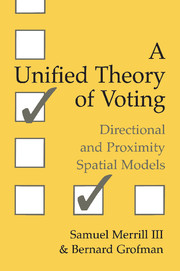Crossref Citations
This Book has been
cited by the following publications. This list is generated based on data provided by Crossref.
Adams, James
and
Merrill, Samuel
1999.
Party policy equilibrium for alternative spatial voting models: An application to the Norwegian storting.
European Journal of Political Research,
Vol. 36,
Issue. 2,
p.
235.
Kitschelt, Herbert
2000.
Linkages between Citizens and Politicians in Democratic Polities.
Comparative Political Studies,
Vol. 33,
Issue. 6-7,
p.
845.
Adams, James
and
Merrill, Samuel
2000.
Spatial Models of Candidate Competition and the 1988 French Presidential Election: Are Presidential Candidates Vote-Maximizers?.
The Journal of Politics,
Vol. 62,
Issue. 3,
p.
729.
Dalton, Russell J.
2000.
Citizen Attitudes and Political Behavior.
Comparative Political Studies,
Vol. 33,
Issue. 6-7,
p.
912.
Merrill, Samuel
Grofman, Bernard
and
Adams, James
2001.
Assimilation and contrast effects in voter projections of party locations: Evidence from Norway, France, and the USA.
European Journal of Political Research,
Vol. 40,
Issue. 2,
p.
199.
Sánchez-Cuenca, Ignacio
2001.
Controlling Governments.
p.
45.
Behnke, Joachim
2001.
Jahrbuch für Handlungs- und Entscheidungstheorie.
p.
49.
Blais, André
Nadeau, Richard
Gidengil, Elisabeth
and
Nevitte, Neil
2001.
The formation of party preferences: Testing the proximity and directional models.
European Journal of Political Research,
Vol. 40,
Issue. 1,
p.
81.
Westholm, Anders
2001.
On the Return of Epicycles: Some Crossroads in Spatial Modeling Revisited.
The Journal of Politics,
Vol. 63,
Issue. 2,
p.
436.
Aguilar, Paloma
and
Sánchez-Cuenca, Ignacio
2001.
Controlling Governments.
p.
105.
Asonov, Dmitri
Schaal, Markus
and
Freytag, Johann-Christoph
2001.
Information Security.
Vol. 2200,
Issue. ,
p.
95.
Clarke, Harold D.
Sanders, David
Stewart, Marianne C.
and
Whiteley, Paul F.
2002.
Downs, stokes and modified rational choice: Modelling turnout in 2001.
British Elections & Parties Review,
Vol. 12,
Issue. 1,
p.
28.
Karp, Jeffrey A.
and
Banducci, Susan A.
2002.
Issues and Party Competition Under Alternative Electoral Systems.
Party Politics,
Vol. 8,
Issue. 1,
p.
123.
Kitschelt, Herbert
and
Smyth, Regina
2002.
Programmatic Party Cohesion in Emerging Postcommunist Democracies.
Comparative Political Studies,
Vol. 35,
Issue. 10,
p.
1228.
Schofield, Norman
2004.
Equilibrium in the Spatial ‘Valence’ Model of Politics.
Journal of Theoretical Politics,
Vol. 16,
Issue. 4,
p.
447.
Grofman, Bernard
2004.
DOWNS AND TWO-PARTY CONVERGENCE.
Annual Review of Political Science,
Vol. 7,
Issue. 1,
p.
25.
Ornstein, Michael
2004.
Le néoconservatisme en Ontario : révolution ou coup d’État ?1.
Sociologie et sociétés,
Vol. 35,
Issue. 1,
p.
95.
Gershtenson, Joseph
2004.
Ideological Centrism and the Electoral Fortunes of U.S. Senate Candidates*.
Social Science Quarterly,
Vol. 85,
Issue. 2,
p.
497.
Warwick, Paul V.
2004.
Proximity, Directionality, and the Riddle of Relative Party Extremeness.
Journal of Theoretical Politics,
Vol. 16,
Issue. 3,
p.
263.
Hillinger, Claude
2004.
Utilitarian Collective Choice and Voting.
SSRN Electronic Journal,





